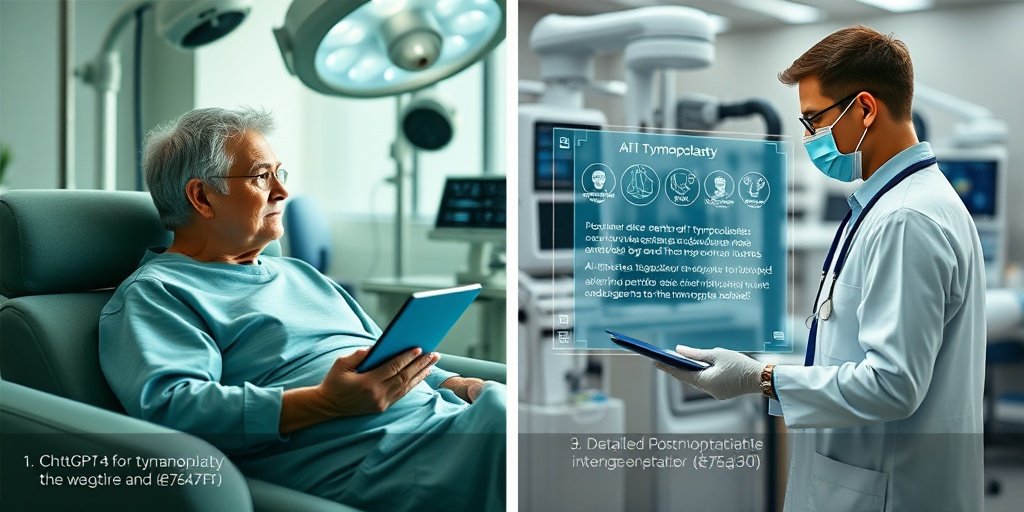⚡ Quick Summary
This study explores the use of ChatGPT-4 as a supplementary tool for postoperative care in patients undergoing tympanoplasty. The findings indicate that ChatGPT-4 can provide accurate and timely information, enhancing patient support, especially in underserved areas.
🔍 Key Details
- 📊 Participants: 10 medical professionals evaluated responses
- 🧩 Focus: 10 commonly asked postoperative questions
- ⚙️ Technology: ChatGPT-4 AI tool
- 🏆 Accuracy: 80% to 100% across different questions
- ⏱️ Response Time: 100% immediate responses
🔑 Key Takeaways
- 🤖 ChatGPT-4 serves as an effective adjunctive tool for postoperative tympanoplasty care.
- 💡 AI technology can bridge gaps in healthcare access, particularly in rural settings.
- 📈 High accuracy ratings (80% to 100%) demonstrate reliability in providing medical guidance.
- ⚡ Immediate response times enhance patient experience and support.
- 🗣️ Clarity and relevance of responses were rated highly, with over 90% deemed easy to understand.
- 🌍 Potential for broader applications in otolaryngology and other medical fields.
- 🩺 Not a replacement for professional medical advice, but a valuable resource.

📚 Background
Tympanoplasty is a critical surgical procedure aimed at repairing perforations in the tympanic membrane. Postoperative care is essential for successful recovery, yet many patients face challenges in accessing timely healthcare guidance, particularly in rural or underserved areas. The integration of AI tools like ChatGPT-4 presents a promising solution to enhance patient education and support during recovery.
🗒️ Study
The study involved posing ten commonly asked postoperative questions related to tympanoplasty to ChatGPT-4. These questions covered essential topics such as signs of infection, activity restrictions, and wound care. The responses were then evaluated by ten medical professionals based on criteria including accuracy, response time, clarity, and relevance.
📈 Results
ChatGPT-4 demonstrated impressive performance, achieving an accuracy rating between 80% and 100% for the questions posed. All responses were delivered immediately, showcasing the tool’s efficiency. Furthermore, over 90% of the responses were rated as clear and directly addressing patient concerns, indicating a high level of understandability.
🌍 Impact and Implications
The findings of this study highlight the significant potential of AI in enhancing postoperative care for tympanoplasty patients. By providing timely and understandable information, ChatGPT-4 can improve patient outcomes and accessibility to healthcare guidance, particularly in areas where professional medical support is limited. This underscores the growing role of AI in otolaryngology and patient support.
🔮 Conclusion
The study illustrates the considerable promise of ChatGPT-4 as an adjunctive tool in postoperative tympanoplasty care. While it cannot replace professional medical advice, its ability to deliver accurate and relevant information enhances patient support and accessibility. As AI continues to evolve, its integration into healthcare practices could lead to improved patient experiences and outcomes.
💬 Your comments
What are your thoughts on the use of AI tools like ChatGPT-4 in postoperative care? We would love to hear your insights! 💬 Leave your comments below or connect with us on social media:
Postoperative Management of Tympanoplasty with ChatGPT-4.0.
Abstract
Background: Tympanoplasty, essential for repairing tympanic membrane perforations, requires careful postoperative care for successful recovery. However, timely access to healthcare guidance can be challenging, especially in rural or underserved areas. ChatGPT-4, an artificial intelligence (AI) tool, offers a potential solution for continuous postoperative support and patient education. This study assesses the feasibility and effectiveness of using ChatGPT-4 as a supplementary information resource for tympanoplasty patients, focusing on its ability to provide accurate, precise, and relevant postoperative guidance in situations where access to healthcare professionals is limited. Methods: Ten commonly asked postoperative questions related to tympanoplasty were posed to ChatGPT-4, including queries on infection signs, activity restrictions, and wound care. Ten medical professionals evaluated the responses based on accuracy, response time, clarity, and relevance. Results: ChatGPT-4 provided responses that aligned well with current medical guidelines, achieving an accuracy rating between 80% and 100% across different questions. Response time was consistently fast, with 100% of responses delivered immediately. Clarity and relevance ratings were also high, with 90% or more responses rated as easy to understand and directly addressing patient concerns. Conclusion: ChatGPT-4 shows considerable promise as an adjunctive tool in postoperative tympanoplasty care, offering timely, understandable information that supports patients following aftercare instructions. While not a replacement for professional medical advice, ChatGPT-4’s capability to deliver accurate and relevant information enhances accessibility to postoperative guidance, particularly in remote or resourcelimited settings, underscoring AI’s growing role in otolaryngology patient support.
Author: [‘Aliyeva A’, ‘Alaskarov E’, ‘Sari E’]
Journal: J Int Adv Otol
Citation: Aliyeva A, et al. Postoperative Management of Tympanoplasty with ChatGPT-4.0. Postoperative Management of Tympanoplasty with ChatGPT-4.0. 2025; 21:1-6. doi: 10.5152/iao.2025.241797